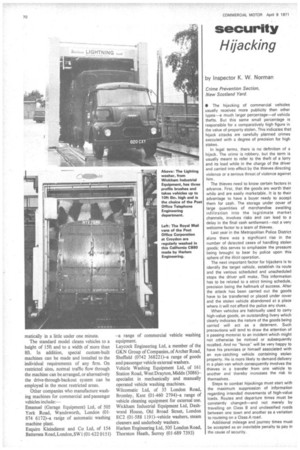security Hijacking
Page 72

If you've noticed an error in this article please click here to report it so we can fix it.
by Inspector K. W. Norman
Crime Prevention Section, New Scotland Yard.
• The hijacking of commercial vehicles usually receives more publicity than other types—a much larger percentage—of vehicle thefts. But this same small percentage is responsible for a comparatively high figure in the value of property stolen. This indicates that hijack attacks are carefully planned crimes executed with a degree of precision for high stakes.
In legal terms, there is no definition of a hijack. The crime is robbery, but the term is usually meant to refer to the theft of a lorry and its load while in the charge of the driver and carried into effect by the thieves directing violence or a serious threat of violence against him.
The thieves need to know certain factors in advance. First, that the goods are worth their while and are easily marketable. It is to their advantage to have a buyer ready to accept them for cash. The storage under cover of large quantities of merchandise awaiting infiltration into the legitimate market channels, involves risks and can lead to a delay in the final cash settlement not a very welcome factor to a team of thieves.
Last year in the Metropolitan Police District alone there was a significant rise in the number of detected cases of handling stolen goods; this serves to emphasize the pressure being brought to bear by police upon this sphere of the illicit operation.
The next important factor for hijackers is to identify the target vehicle, establish its route and the various scheduled and unscheduled stops the driver will make. This information has to be related to a strict timing schedule, precision being the hallmark of success. After the attack has been carried out the goods have to be transferred or placed under cover and the stolen vehicle abandoned at a place where it will not afford the police any clues.
When vehicles are habitually used to carry high-value goods, an outstanding livery which clearly indicates the nature of the goods being carried will act as a deterrent. Such precautions will tend to draw the attention of a passing motorist to an incident which might not otherwise be noticed or subsequently recalled. And no "fence" will be very happy to have his premises or himself associated with an eye-catching vehicle containing stolen property. He is more likely to demand delivery in a plain van which consequently involves the thieves in a transfer from one vehicle to another and thereby increases the risk to themselves.
Steps to combat hijackings must start with the maximum suppression of information regarding intended movements of high-value loads. Routes and departure times must be constantly changed—and not merely by travelling on Class B and unclassified roads between one town and another as a variation to routeing on a Class A road.
Additional mileage and journey times must be accepted as an inevitable penalty to pay in the cause of security.




































































































































